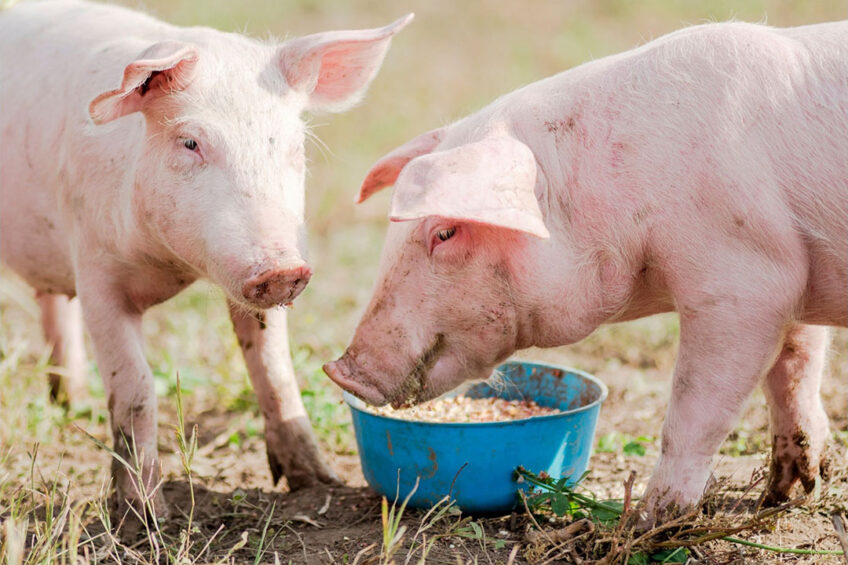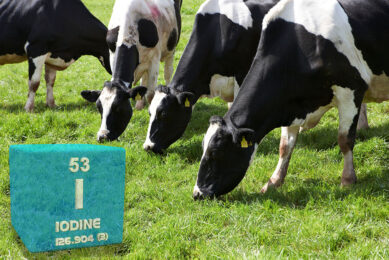Application of xylanase in sow diets

Wheat, one of the main ingredients used in swine diets, contains 13% dietary fibres. Dietary fibres reduce the risk of gastric ulcers and enhances sow productivity by improving colostrum production and reducing stillbirth rate.
However, dietary fibres cannot be degraded and fully digested by monogastric animals such as pigs due to lack of corresponding digestive enzymes. Thus, the undigested nutrients signify economic loss in the form of feed, cause nutrient waste, and reduce feed efficiency. Supplementing degrading enzymes such xylanase improves the nutrient digestibility, feed efficiency, growth performance, cost of gain, and reduces the waste nutrient outflow.
Dietary fibre in pig diets
Dietary fibre is defined as the remains of plant components or related carbohydrates that are consumable but are not broken down by enzymes secreted in the gut; however, they are fermented in the large intestine and utilised by microbes. Cereal grains and legumes serve as the first source of dietary fibre in pig diets providing energy and protein. The cell wall of cereal grains is high in non-starch polysaccharides which are the most dominant component of dietary fibre.
What is xylanase?
An enzyme is a substance produced by a living organism to initiate or to accelerate chemical and biochemical reactions. Feed enzymes are commercially produced by the fermentation of selected microorganisms. Xylan is a major structural polysaccharide in plant cells such as wheat. Xylan makes up 5.4% to 8.0% of Australian wheat, 5.5% to 6.5% of North American wheat and 6.6% to 8.2% of Chinese wheat, and it is primarily responsible for the anti-nutritional effects of wheat. Xylan breakdown is restricted due to its heterogeneous nature which can be overcome by xylanase. Xylanase is produced by several microorganisms such as bacteria, fungi, yeast, and algae. Xylanase decreases the viscosity of digesta caused by the soluble fractions of arabinoxylans and it breaks glycosidic bonds in the xylan main chain to liberate encapsulated nutrients such as protein and starch.
Impact of xylanase supplementation
In 2018, Zhou and colleagues showed that supplementing xylanase improves the digestibility of nutrients, provides energy, and reduces the need for added dietary fat without negative impacts on performance. The study determined that xylanase supplementation improves the apparent total tract digestibility of total non-starch polysaccharides, gross energy, dry matter, and nitrogen in lactating sows. In 2007, de Souza and colleagues found that ileal digestibility and the apparent total tract digestibility of dry matter and nitrogen are increase by xylanase supplementation in lactating sows fed a corn-soybean meal diet. Furthermore, xylanase enhances the passage rate of digesta from the stomach and through the small intestine, thus, increasing feed intake and total nutrient digestibility of lactating sows. On the other hand, extreme body mobilisation and loss of back fat in lactating sows enhance the weaning to oestrus interval of sows, decrease ovulation rates and embryonic survivals, which in turn negatively affect subsequent reproductive performance. Feeding lactating sows, the xylanase supplemented diet reduces body mobilisation and eliminates the need for restoring body condition in the subsequent gestation period. In 2016, Upadhaya and colleagues found that xylanase and cellulase supplementation increases the triglycerides concentration in lactating sows and the average daily gain of their piglets.
Concluding remarks
Wheat is a major ingredient in swine diets containing 13% dietary fibre. Dietary fibre reduces the risk of gastric ulcers and enhances sow productivity. However, dietary fibre is indigestible in pig gut because of lack of corresponding digestive enzymes. Supplementing xylanase to a coarsely ground lactating diet based on wheat improves sow feed intake, increases nutrient digestibility, reduces sow body weight loss throughout lactation, and improves subsequent reproductive performance. Further research is required to determine what feed ingredients or compounds are poorly digested by pigs to select effective enzymes to improve efficiency.
Join 26,000+ subscribers
Subscribe to our newsletter to stay updated about all the need-to-know content in the feed sector, three times a week. Beheer
Beheer











 WP Admin
WP Admin  Bewerk bericht
Bewerk bericht